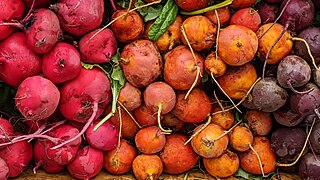Cookbook:Beet
| Beet | |
|---|---|
 | |
| Category | Vegetables |
Cookbook | Recipes | Ingredients | Equipment | Techniques | Cookbook Disambiguation Pages | Ingredients
The beet, sometimes called beetroot to distinguish it from the edible leafy green upper part, is a root vegetable.
Characteristics
[edit | edit source]Beets have a uniquely strong, sweet flavor and can come in a variety of colors,[1] with the most common being an intense purple-red.[1][2] Most modern varieties are spherical, though they can also be long and carrot-shaped.[3] Young beets, about 1½ inches in diameter, are fine textured, tender,[4] and excellent in salads. Medium- and large-size beets are good for cooking; very large roots are too woody for eating regardless of cooking method.[1]
Selection and storage
[edit | edit source]Whatever size of beets you choose, look for smooth, hard, uniformly round beets that are free of cuts and bruises.[4] If applicable, remove the beet greens and use immediately. Store beets with their tops chopped off in individual plastic bags in the coolest part of the refrigerator—these should last up to one week.[4] Once cooked, beets can be frozen with their peels removed.[4]
Wash and scrub the beets before cooking. Beets peel best after cooking, and they will stain many things they come into contact with—wear gloves if you wish to avoid stained hands.
Uses
[edit | edit source]Tender beets can be eaten raw, but they are often cooked before eating by boiling, steaming, or roasting.[4] In many applications, the skin can be left on,[4] especially when boiling to prevent color loss.[1][3] Cooked beets can be sliced and served as a vegetable on one side of a plate. They are often used in Eastern European soups. Sugar beets[4] are a common source of refined white sugar, which is known as beet sugar. Beet juice[4] is commonly used for coloring foods.
Beet greens can be used like other leafy greens such as chard.[1]
Seasonality
[edit | edit source]| Seasonality tables | Autumn | Winter | Spring | Summer | All year | ||||||||||||
|---|---|---|---|---|---|---|---|---|---|---|---|---|
| Beet | Jan | Feb | Mar | Apr | May | Jun | Jul | Aug | Sep | Oct | Nov | Dec |
| Northern hemisphere | ||||||||||||
| Southern hemisphere | ||||||||||||
Beetroot has a long season that starts in the summer and lasts through the winter.
Gallery
[edit | edit source]-
Beets of various colors
-
Inside of a yellow beet
-
Inside of a variegated beet
-
Red beet pieces
Recipes
[edit | edit source]References
[edit | edit source]- ↑ a b c d e Gisslen, Wayne (2014-04-15). Professional Cooking. Wiley. ISBN 978-1-118-63672-5.
- ↑ Labensky, Sarah R.; Hause, Alan M.; Martel, Priscilla (2018-01-18). On Cooking: A Textbook of Culinary Fundamentals. Pearson. ISBN 978-0-13-444190-0.
- ↑ a b Davidson, Alan (2014-01-01). Jaine, Tom (ed.). The Oxford Companion to Food. Oxford University Press. doi:10.1093/acref/9780199677337.001.0001. ISBN 978-0-19-967733-7.
- ↑ a b c d e f g h "Beets Are the Sweetest Root Vegetable You'll Cook With". The Spruce Eats. Retrieved 2023-12-26.




